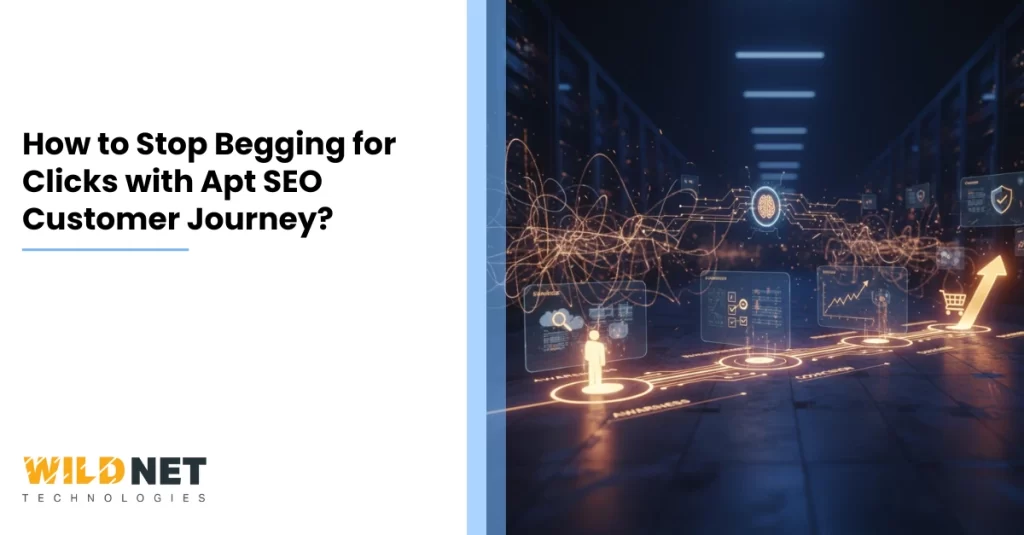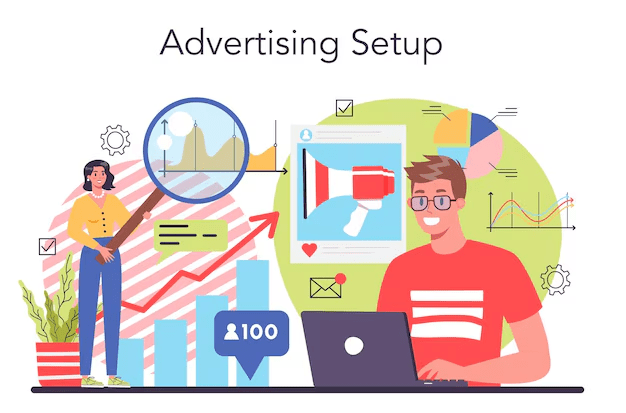Summary
You can stop begging for links and start guiding users with a smarter SEO customer journey. All you have to do is align your SEO strategy according to each stage that includes awareness, consideration, and decision. This way you can attract the right audience, build trust naturally, and boost conversions.
Key Takeaways
- Focus on the full journey, not just clicks.
- Create stage-specific content that answers what users need at each step instead of pushing sales too early.
- Make sure your SEO aligns with real user behavior and intent.
Table of Contents
- Introduction
- A Few Facts
- Why the “begging for clicks” mindset hurts you
- Understanding the Stages of the SEO Customer Journey
- Why this journey mindset changes everything
- How to build your smarter SEO customer journey(step-by-step)
- What to watch out for (so you don’t fall back into begging-mode)
- Final Thoughts
- Read More
- FAQs
Introduction
Aren’t you tired of shouting into the void, hoping someone will click your link? Yes, we all are.
But is it even necessary?
No.
Shouting “Choose me, choose me!” isn’t a strategy, it’s begging. And if you’re doing SEO that way, you’re missing the bigger picture.
It’s time to stop begging for clicks and instead build a smart SEO customer journey that leads people naturally from–
“Hmm, what’s that?”
to
“Yes, I’ll buy this!”
In this blog, we’ll explore the ways in which you can revise your strategy of SEO customer journey and ensure a constant flow of ready-to-buy visitors.
A Few Facts
- 86% of respondents say AI will dramatically change the way businesses deliver customer experiences.(Hubspot)
- 46% of consumers want personalized communication before they can fully trust a brand.(Hubspot)
- Content marketing and SEO deliver the highest return on investment. Databox
Why the “begging for clicks” mindset hurts you
You might think that it’s an important part of your strategy, but it’s actually detrimental. How? Well, suppose you’re at a party.
Someone walks up to you and just yells “hey, look at me!”. You might look towards them for a few seconds, and then walk away.
Now, imagine another scenario, where someone catches your eye. They share something interesting and show you that they care. This will naturally lead you to their side of the party.
The same thing goes for websites and their visitors.
When SEO for you is all about getting more and more links, followed by a hope that they’ll convert, you ignore something very important. What’s that? It’s basically the different stages that people go through while making a decision.
First, they discover.
Second, they evaluate.
Third and final, they decide.
And that’s exactly what the SEO customer journey is about.
Understanding the Stages of the SEO Customer Journey
When you align SEO and customer journey goals, you move from chasing clicks to building lasting engagement. The journey is divided into three broad stages. Here, you’ll learn what things you need to take care of in each stage.
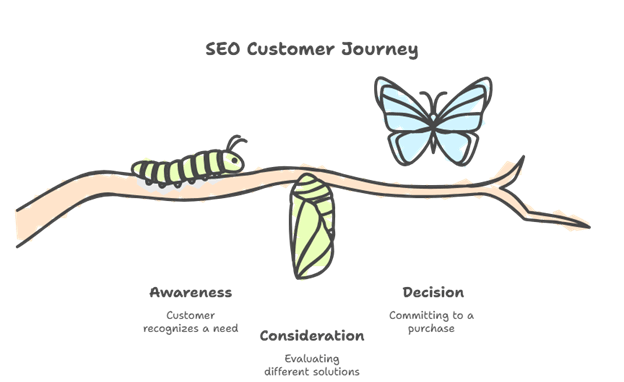
3 Stages of SEO Customer Journey
Awareness
What’s happening? A person realises they have a problem or need. They’re asking general questions.
What kind of SEO works? Something that answers questions like informational content, blog posts, and ‘how-to’ guides.
Your action:
- Identify topics your audience is googling when they just feel a need or are curious.
- Create content that helps them, without heavy sales language.
- Make sure the content is easy, friendly, and builds trust.
Consideration (Middle-Funnel)
What’s happening? The person knows a bit more. They’re comparing options, looking for solutions, and doing research.
What kind of SEO works? Comparison pages, case studies, how your solution stacks up, deeper blog posts.
Your action:
- Build content around “vs”, “best for X”, “how this works” type queries.
- Show how you solve their issue. Provide proof (case studies, testimonials).
- Create gentle paths toward conversion, but don’t push too hard yet.
Decision
What’s happening? The person is nearly ready. They just need confirmation, trust, maybe the best deal.
What kind of SEO works? Product pages, service landing pages, pricing breakdowns, strong CTAs.
Your action:
- Ensure your landing pages answer all lingering questions (pricing, FAQs, evidence).
- Strong, clear calls-to-action.
- Remove friction: fast page loads, mobile friendly, trust signals.
- Align your keywords with those decision-stage queries (“buy”, “best deal”, “purchase”).
Why this journey mindset changes everything
When you start grasping how the customer journey influences SEO, a few great things happen:
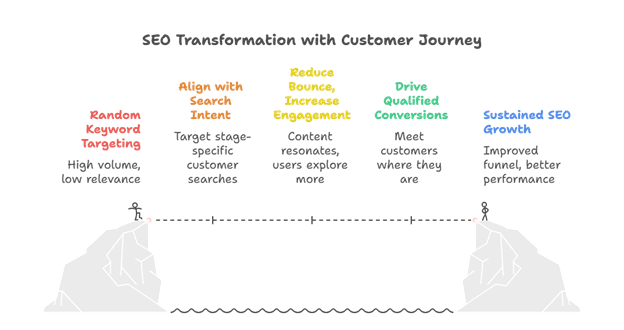
Things that happen when you focus SEO customer journey
- Better alignment with search intent: Instead of targeting random keywords just because its volume is high, you target what people are actually searching at that stage.
- Reduced bounce / higher engagement: If someone lands at the right stage, the content resonates better, making them stay and explore more.
- More conversions: You’re not just getting clicks, you’re getting qualified clicks which convert because you met them where they were.
- Sustained growth: Technical SEO and site health affect each stage. So improving the funnel means better performance over time
Basically, the aim is to free you from the desperation of floods of links to actual useful clicks.
How to build your smarter SEO customer journey(step-by-step)
Here’s a friendly, actionable checklist to ensure you align your content strategy with customer journey SEO. Let’s get you started.
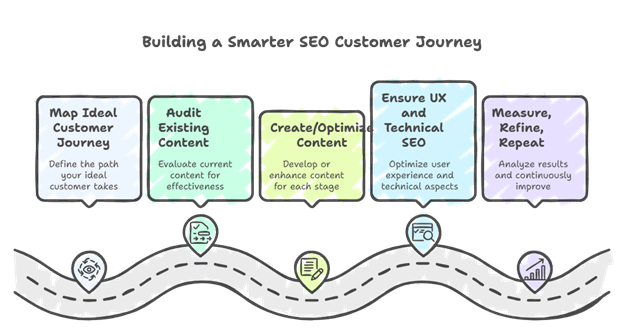
Building a Smarter SEO Customer Journey
Step 1: Map out your ideal customer’s journey.
- What are the stages (awareness, consideration, decision)?
- What questions might they ask at each stage?
- What keywords or queries map to those questions?
Mapping SEO keywords and customer journey funnels helps you create stage-specific content that moves users smoothly toward conversion.
Step 2: Audit your existing content.
- What do you already have?
- Which content aligns with each stage?
- Where are the gaps?
Step 3: Create or optimize content according to stage.
- Awareness: blog posts, guides, FAQs.
- Consideration: comparison pages, how-it-works, deep dives.
- Decision: landing pages, product/service pages, pricing etc.
Step 4: Ensure user experience and technical SEO are solid.
- Make sure the site is fast, mobile-friendly, and accessible.
- Site health influences all stages.
- Internal linking: allow people to seamlessly move from awareness to decision.
- Clear CTAs tailored to each stage (not all “Buy now” at top of funnel).
Step 5: Measure, refine, repeat.
- Track analytics: not just traffic, but how people navigate your funnel.
- Which content is working at each stage? Where are drop-offs?
- Optimize underperforming content or create new content to fill gaps.
What to watch out for (so you don’t fall back into begging-mode)
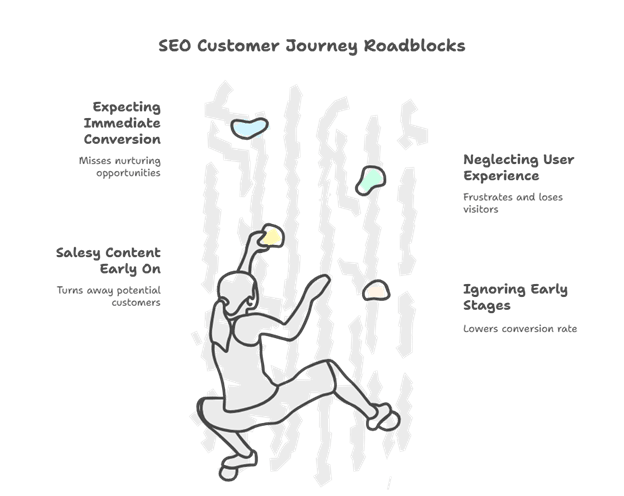
Roadblocks of SEO Customer Journey
- Don’t only target high-volume transactional keywords and ignore the earlier stages. That’s begging for clicks with low conversion chances.
- Don’t write content that’s purely salesy at the awareness stage, people aren’t ready for that yet.
- Don’t ignore user experience or technical issues. A fast site, mobile-friendly design, and clear navigation matter just as much.
- Don’t assume once someone lands, they’ll convert immediately. They may need nurturing.
Final Thoughts
In the current times of pure competition, shouting “choose me” might seem a brilliant thing to do. But, in reality it’s not enough to convert clicks into actual clients.
If you really wish to see results, understanding the role of SEO in the customer journey helps marketers craft content that supports users at every step. You must not treat SEO to get links but as a way to guide people through the SEO customer journey. Build content and structure that meets your audience’s needs at each phase. From awareness, consideration, to decision. Use keyword research with intent, create the right content, ensure your site delivers, and measure your way forward.
By actually giving importance to understanding how SEO supports the customer journey, you’ll find yourself showing up at the right time, in the right way. The best part? You won’t be begging for clicks anymore. You’ll simply earn them.
If you’re looking for complete SEO services for your business, get in touch with Wildnet Technologies today.
Wildnet Technologies is a leading 360-degree digital services provider. With 19 years of strong foundation in the market, we’ve helped 4100+ brands achieve remarkable results.
Read More
Many stones are still unturned. Explore more:
- From Click to Conversion: How to Map and Optimize the Entire Customer Journey in 2025
- AI-Powered Omnichannel Marketing: Transforming Customer Journeys
- How to Conduct a Technical SEO Site Audit: Step-by-Step Guide
- SEO Principles: The Ultimate Guide to Ranking Higher in 2025
FAQs
Question 1. What is the customer journey in SEO?
Answer. The customer journey in SEO (also called the SEO customer journey) is the path a person takes from discovering your brand on search engines to eventually converting, whether that’s buying, signing up, or engaging. It includes three main stages:
- Awareness: discovering they have a need or problem.
- Consideration: researching solutions.
- Decision: choosing the best option (hopefully, you!).
- Smart SEO targets all these stages, not just the final click.
Question 2. What are the 7 steps to follow while mapping the customer journey
Answer. Here’s a simple 7-step process for mapping your customer journey:
- Define your audience personas – know who you’re talking to.
- Identify key touchpoints – where users converse with your brand.
- List their goals and pain points at each touchpoint.
- Map the stages – awareness, consideration, decision, and post-purchase.
- Align content and keywords to each stage.
- Track data and behavior (analytics, heatmaps, etc.).
- Refine and optimize – update based on what’s working.
Doing this helps you connect SEO strategy to real user behavior, not just keywords.
Question 3. How does SEO support each stage of the customer journey?
Answer. SEO ensures people find the right content at the right time.
- In the awareness stage, you rank for informational queries (“how to fix…”).
- In consideration, you target comparison or solution-based keywords (“best tools for…”).
- In the decision stage, you show up for transactional terms (“buy,” “pricing,” “demo”).
- Good SEO acts like a guide, gently leading users from curiosity to conversion.
Question 4. Why is understanding the SEO customer journey so important?
Answer. Because not everyone is ready to buy right away! If you only optimize for “buy now” keywords, you miss out on people still learning or comparing options.
Understanding the SEO customer journey helps you meet users where they are, build trust earlier, and guide them naturally toward conversion — without “begging for clicks.”
Question 5. How can I improve my SEO customer journey today?
Answer. Start small:
- Audit your existing content and tag it by stage (awareness, consideration, decision).
- Fill in the gaps with helpful content for early-stage users.
- Improve your internal links to guide users from blog posts to product pages.
- Test your hero shot and calls-to-action, small tweaks can make a big difference.
- And remember: SEO is not just about traffic, it’s about the right traffic that moves through your funnel smoothly.
